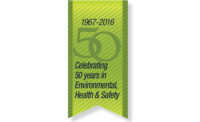Form 301 – “Injury and Illness Incident Report,” basically asks employers to “tell us how the recordable) injury occurred.”
Form 301 also asks: What was the worker doing immediately prior to the injury occurring? Perhaps climbing a ladder while carrying roofing materials; spraying chlorine from hand sprayer; daily computer key-entry.
What was the result? Be specific, asks OSHA. Don’t say the employee was hurt, in pain, or sore. Instead, the employee suffered a strained back, or chemical burn on one hand, or carpal tunnel syndrome.
How did this harm occur? Again, be specific. When the employee fell from the ladder, he hit a concrete floor. Or the chlorine spray from the broken gasket burned his hand. Or the employee was operating a radial arm saw and developed soreness in his wrist over time which was diagnosed as carpal tunnel.
OSHA’s Form 300 – “Log of Work-Related Injuries and Illnesses,” asks employers to further analyze each recordable incident. Where did it occur? Did the injury or illness result in death, days away from work, or the employee remained
at work in a different job, or was there another
outcome?
How many days was the employee away from work or on job transfer or restricted duty? Describe the nature of the mishap: Was it an injury, skin disorder, respiratory condition, poisoning, hearing loss, or another type of illness?
Public apathy?
I’m skeptical about how much of all this John Q. Public will digest and understand. I haven’t seen a public uproar over access to OSHA’s “Establishment Search,” which gives details on a company’s enforcement history and violations. Only in infrequent, long-form investigative pieces, the likes of which The New York Times and PBS combined forces on to uncover McWane Inc.’s long and sorry history of OSHA and EPA violations, have reporters made use of “Establishment Search.”
Still, there is no denying if this proposal becomes law, safety and health professionals along with CEOs and upper management will confront unprecedented public scrutiny about workplace safety hazards and outcomes. I doubt this will happen any time soon. The U.S. Chamber of Commerce wasted no time in November protesting the proposal.
Business concern
“Just because you have an injury, it does not mean there was employer fault,” Marc Freedman, executive director of labor law policy at the U.S. Chamber of Commerce, told the Associated Press. “Reporting the injury records does not tell the full story of the company.”
“Making company-specific data on injuries available for all to see would be a major problem and would likely lead to companies being targeted by outside groups who want to characterize these employers as having bad safety records,” Freedman said.
That sound you hear is the engines revving up in the business community for the race to the courthouse to overturn the public online posting plan if it does become a final recordkeeping regulation.
OSHA’s aims?
Fear is the motivator here. Not so much of what the public might make of this newly accessible injury and illness information. But what OSHA might do with it. OSHA currently does not acquire establishment-specific injury and illness information from an establishment in a particular year unless the site was inspected, was part of the OSHA Data Initiative (which collects only summary data from high hazard industries), and/or reported a fatality or multiple-hospitalization event.
Now, a business attorney told ISHN, OSHA could send inspectors to a worksite where an amputation sent one worker to the hospital. According to the U.S. Bureau of Labor Statistics, more than one-half of the nearly 3.0 million private industry injury and illness cases reported nationally in 2012 were of a more serious nature that involved days away from work, job transfer, or restriction (DART cases). These are the cases that concern OSHA the most, but the agency (and state OSHA programs) falls far short of having enough inspectors to follow-up on 1.8 million DART cases.
In 2010, OSHA and its state partners inspected approximately 1% of establishments under OSHA jurisdiction (approximately 98,000 inspections, out of 7.5 million total establishments), according to the agency.
A new worry
I think the real rub here is not the short arms of OSHA enforcement, but public accountability for worker safety, something new for businesses to worry about. Sure, a number of the big boy corporations report their annual injury and illness rates in annual reports, but not in the details required by OSHA’s Forms 300 and 301. Who doesn’t want to look good when it comes to safety performance? It’s been said for years, safety is like motherhood and apple pie. High rates of injuries and illnesses are indefensible. So are repeated serious, life-altering injuries and fatalities occurring at a worksite. There must be accountability for these outcomes.
After all, accountability is accepted in all sorts of scenarios where the stakes are not life and death. CEOs are fired for poor profit performance. Managers are fired for quality problems, accounting irregularities, harassment, and salacious extra-curricular activities in their personal lives. Athletic coaches in any sport are summarily dismissed for losing too many games, from high school to the pros. Airline pilots, train engineers and ship captains are reprimanded, sometimes discharged, and exposed in the press after crashes. Political appointees, presidential cabinet members, ambassadors and lower level political staffers fall on their swords for misdeeds, miscalculations, errors in judgment, and making their president look bad. Military officers are demoted and disciplined for similar miscues.
There is growing public pressure to hold school teachers more accountable for student scores, and to hold physicians and hospitals more accountable for medical errors.
Not wanting to get caught is human nature
Why should workplace safety and health performance be an exception? Oh, you’ll have more companies cheating, under-reporting their number of injuries and illnesses to escape scrutiny and again, the rather limited wrath of OSHA, say critics of the public posting proposal. Well, yes, that is human nature and it won’t change. Teachers erase and correct students’ test scores to keep their jobs and reputations. Recall the cover-up jobs on Wall Street and in banking after the 2009 meltdown. How many accounting books have been cooked over the years?
Sometimes you can duck, or try to duck, accountability; sometimes you just can’t. A state governor or senator or congressman does a lousy job, he or she loses the next election. A coach can’t hide the losses. A general can’t hide a military disaster. A mine owner can’t hide a deadly cave-in. A reporter can’t lie his or her way out of one fabricated story after another. They’re caught, fired, and humiliated.
Safety consultants and organizational psychologists say if you want a strong cultural emphasis on safety, you’ve got to have accountability. Accountability creates a degree of tension that’s positive, keeps people sharp. I’ve heard no argument against safety accountability. What OSHA has done is raise the ante and proposed to make safety performance accountability a matter of public record. Good. Safety performance deserves that accountability. Some businesses should be anxious about their performance, and do something to improve it, rather than de-emphasize it.




